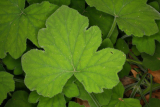Additional notes (click to expand)
Medicinal
The following notes refer to the related species P. odoratissimum.
In traditional medicine the whole plant is an aromatic herb with astringent, tonic and antiseptic effects. It is used internally in the treatment of debility, gastro-enteritis and haemorrhage. Externally, it is used to treat skin complaints, injuries, neuralgia and throat infections. It is used in the treatment of burns, sores and shingles[Bown. D. Encyclopaedia of Herbs and their Uses. Dorling Kindersley, London. 1995].
https://pfaf.org https://pfaf.org/User/Plant.aspx?LatinName=Pelargonium+odoratissimum
Other use
The peppermint-scented leaves can be used as a culinary herb. Barbara Hey (1994) suggests lining the tin with them before baking a chocolate cake. They can also be used to flavour puddings, jellies and hot or cold drinks. The leaves are good in pot-pourris and can be used to stuff pillows. Fresh leaves make a soothing poultice for bruises and sprains.
https://pza.sanbi.org https://pza.sanbi.org/pelargonium-tomentosum
Geographical distribution
- Africa, Southern Africa, Cape Provinces
Pelargonium tomentosum Jacq. (Sc)
Family: GERANIACEAEGenus: Pelargonium
Species: tomentosum Jacq. (Sc)
Common names: Pennyroyal Pelargonium; Peppermint-scented Pelargonium
Distribution summary: South Africa (W Cape)
Habit: Short-lived Perennial
Hardiness: H3 - Half hardy; unheated greenhouse/mild winter
Habitat: Frequently on sandy soils
Garden status: Currently grown
Garden location: Southern Hemisphere Wolfson bed (N), Southern Hemisphere (K), Plants in pots (POT)
